I’m lucky to have grown up with a Filipino household and a mother who cooks some of the best Filipino food I’ve ever had. You might be thinking I’m biased, and that everybody says this. But know that everyone in the family also oo’s and aah’s when my mom brings food, be it savory or sweet, to a family party. All this is to say that I’ve eaten Filipino food my whole life and want to share with you what I personally think are the best Filipino foods you should try.
Filipino food is popping up in more and more restaurants these days, from fast food joints like Jollibee to fusion restaurants like Terrace by Mix Mix in Costa Mesa to even Michelin-starred Kasama in Chicago. There is an endless list of Filipino desserts to crave and even unique ways of sharing a meal, like kamayan (or boodle fights).
Many Filipino foods are shaped by indigenous, Chinese, Spanish, Japanese, American, and many more cultures–this is what makes this cuisine so special. If you’re new to Filipino and Filipino American cuisine, let this best Filipino foods list guide you!
1. Pork Sinigang (Filipino Sinigang na Baboy)
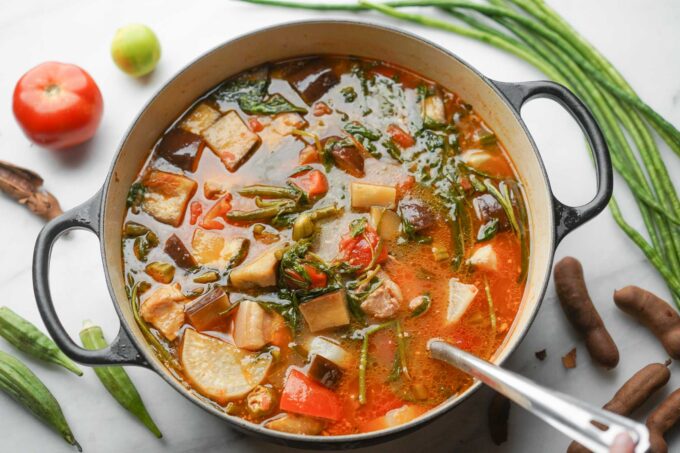
This tangy and savory stew is a Filipino staple for a reason–it hits the spot on a cold day, and you need a pick-me-up. The term “sinigang” means “stewed.” While sinigang comes in different types, like sinigang na isda (fish) or sinigang na baka (beef), my favorite is sinigang na baboy (pork).
Sinigang uses a tamarind base to give you that slightly sour taste that perfectly pairs with the fattier protein options like pork. Most modern recipes use tamarind as the sour ingredient, but traditionally, some recipes include gooseberry plants, mangoes, and other fruits to create the sour component.
You have plenty of options for making this popular stew at home; you can use tamarind paste from the store, make your tamarind paste from fresh fruit, or even just use a premade packet of Mama Sita’s sinigang seasoning–there’s no judgment here. Besides the tamarind and pork, this stew is full of veggies like long string beans, okra, eggplants, tomatoes, finger chilies, and water spinach.
2. Lumpia Shanghai (Crispy Filipino Spring Rolls)
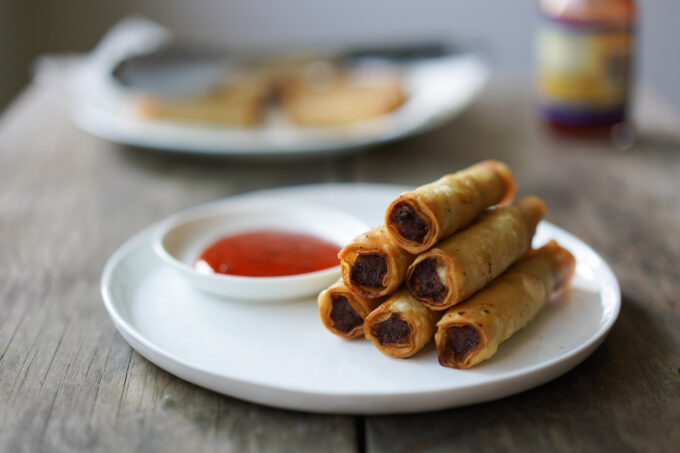
I always dream about lumpia Shanghai, and what’s not to love about ultra-crispy spring rolls with steaming hot, savory pork centers? These are the Filipino version of fried spring rolls and one of the most popular Filipino dishes. And for good reason, because they’re so delicious, you can’t just eat one. At every Filipino party I go to, I need to pace myself because this appetizer is usually one of the first things up for grabs, and if I eat too many, I can’t eat the rest of my meal.
There are different types of lumpia, and lumpia Shanghai is just one variety. For example, lumpia sariwa is made with a fresh wrapper, almost like a thin egg crepe. My lumpia Shanghai recipe includes ground pork filled with freshly minced garlic, carrots, onion, and soy sauce wrapped in a wheat-based spring roll wrapper.
Like many foods from the Philippines, lumpia originated from Hokkien immigrants and traders from the precolonial period. If you’re not in the mood to make lumpia Shanghai from scratch, you can find them at many local Filipino restaurants or in the frozen section at your local grocery store like Albertsons.
3. Silog/Traditional Filipino Breakfast – Longanisa, Pork Tocino, & Garlic Fried Rice
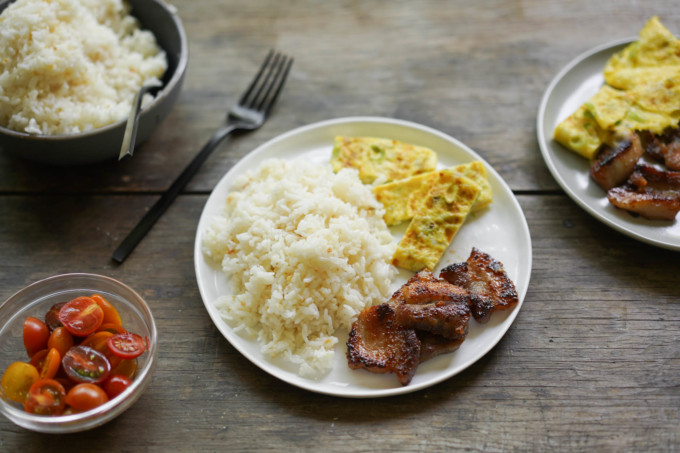
There’s nothing quite like waking up in the morning to a full Filipino breakfast full of fragrant garlic fried rice (sinangag Filipino), sweet pork tocino and longanisa, and fried eggs. This breakfast is not for the faint of heart and will cure many hangovers if you’re in need of carbs and protein.
When you first go to a Filipino restaurant serving breakfast, you’ll find different Silog varieties based on the type of protein paired with extra garlicky fried rice and eggs. Silog combines sinangag (fried rice) and itlog (eggs). While there are over a dozen types, my favorites are tocilog, which includes chicken or pork tocino, and longsilog, which is longanisa. My favorite spots to get silog nearby are Salo Salo Grill in Artesia or Jollibee if I’m in a rush.
4. Filipino Spaghetti (w/ Sweet Spaghetti Sauce)
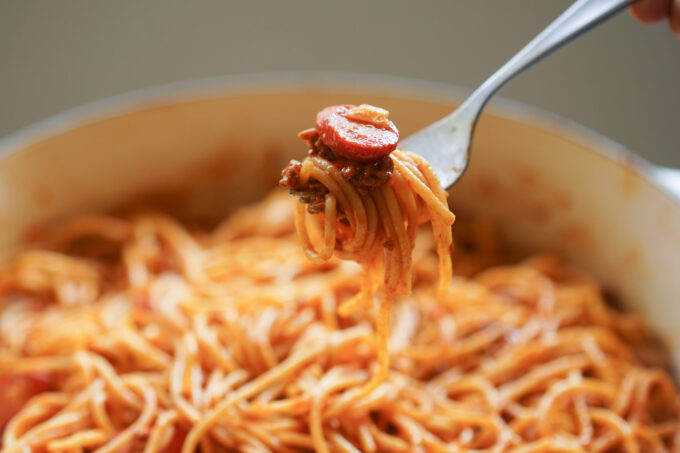
No, you’re not reading that wrong. This spaghetti is definitely sweet! And you won’t believe the traditional ingredient that makes this remixed pasta dish–if you guessed the words banana and ketchup, then you’d be correct. This Filipino staple originated during WWII during the American occupation of the Philippines and was actually influenced by the sweet pasta General MacArthur tasted in Japan. When he requested a similar dish in the Philippines, they used banana ketchup instead of marinara sauce.
To make Filipino spaghetti, combine onions, canned tomatoes, banana ketchup, garlic, dark brown sugar, and my secret ingredient, fish sauce. It gives an extra umami flavor to this sauce and rounds out the sweet taste with savory saltiness.
This version includes sliced hot dogs and shredded Velveeta cheese–essential ingredients do this dish. If you don’t have time to make this yourself, I recommend stopping by your local Jollibee to grab a cheap meal. It’s pretty tasty and affordable.
5. Filipino BBQ Pork Skewers
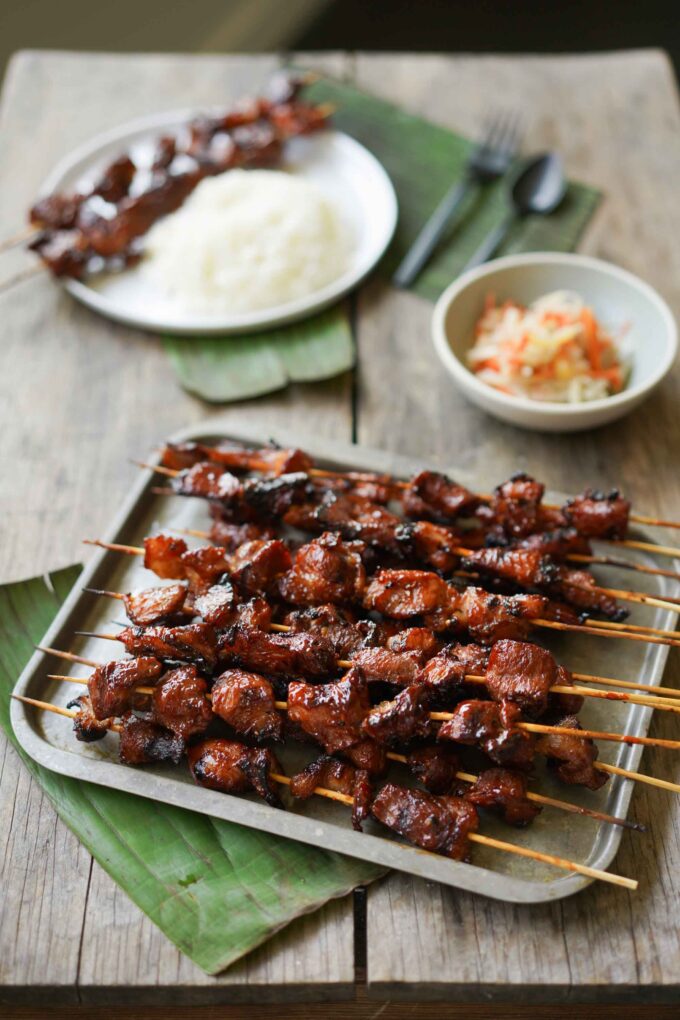
My mouth just salivates, thinking about Filipino BBQ pork skewers. From the juicy pieces of marinated pork to the sweet and savory glazed brushed on just before you take them off the sizzling grill, everything about these skewers is satisfying. I’ve been making these Filipino BBQ pork skewers for over a decade, and no matter how many skewers I make, they run out quickly at every party. Be warned, they are addicting.
While there are also chicken skewers, pork skewers are often the preferred meat of the Philippines because pigs are indigenous to the land and are used in many dishes. This recipe uses traditional ingredients like banana ketchup, sprite, and Datu Puti white vinegar for the marinade.
The meat marinades in the sweet and savory mixture for at least four hours, and it’s worth the wait–the pieces of pork get super tender, juicy, and flavorful. It pairs perfectly with homemade atchara (Filipino pickles) which cuts the fattiness of the meat. If you don’t have time to make it at home, you can purchase these from plenty of Filipino restaurants, like Grill City inside Seafood CIty.
6. Sizzling Pork Sisig (Charcoal Grilled)
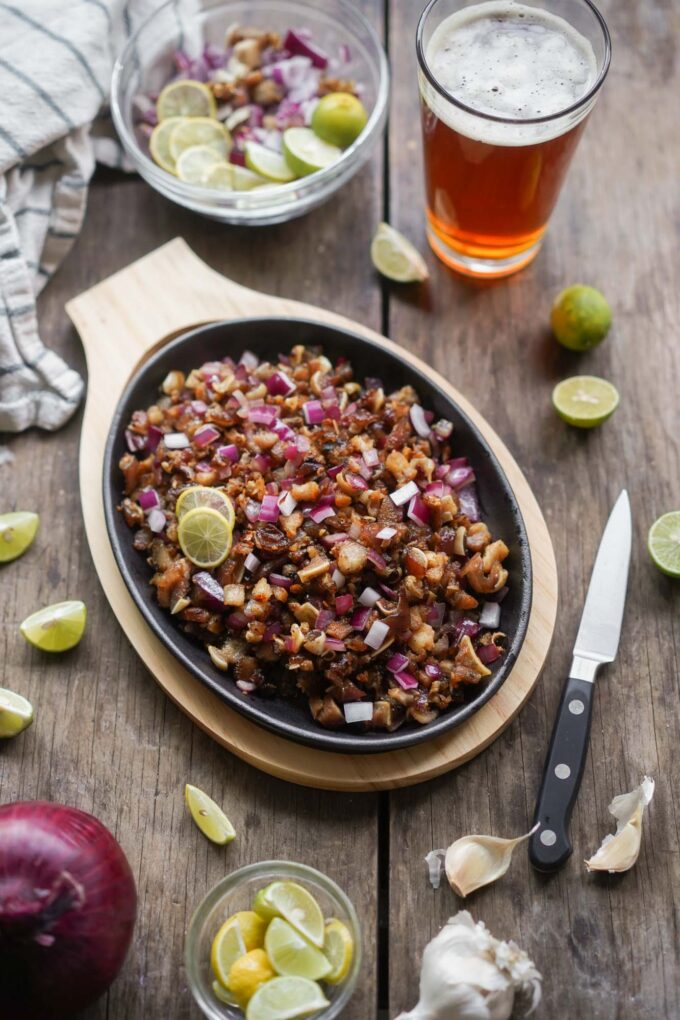
Sisig is one of those mouthwatering foods that make you salivate at the thought of taking one bite of the hot and crunchy pieces of pork, sweet onions, and zesty lime juice. It was one of the late Anthony Bourdain’s favorite drinking foods when visiting the Philippines, and we can’t deny it.
This dish originated in the Pampangan region and started in the kitchen of Lucia Cunanan, who took the leftover pig ears from the American Clark Air Base. She chopped up the unused pig ears, added fattier pieces of pork, and made them into a new drinking food. She used multiple cooking techniques for this recipe: braising, chargrilling, and sauteing with onions, soy sauce, limes, and seasonings.
It truly is a labor of love to make sizzling pork sisig, but if you don’t have hours at home to make this street food dish, you can always buy it at your local Filipino restaurants, like Grill City or Salo Salo Grill.
7. Kare Kare (Oxtail, Vegetable & Peanut Sauce Stew)
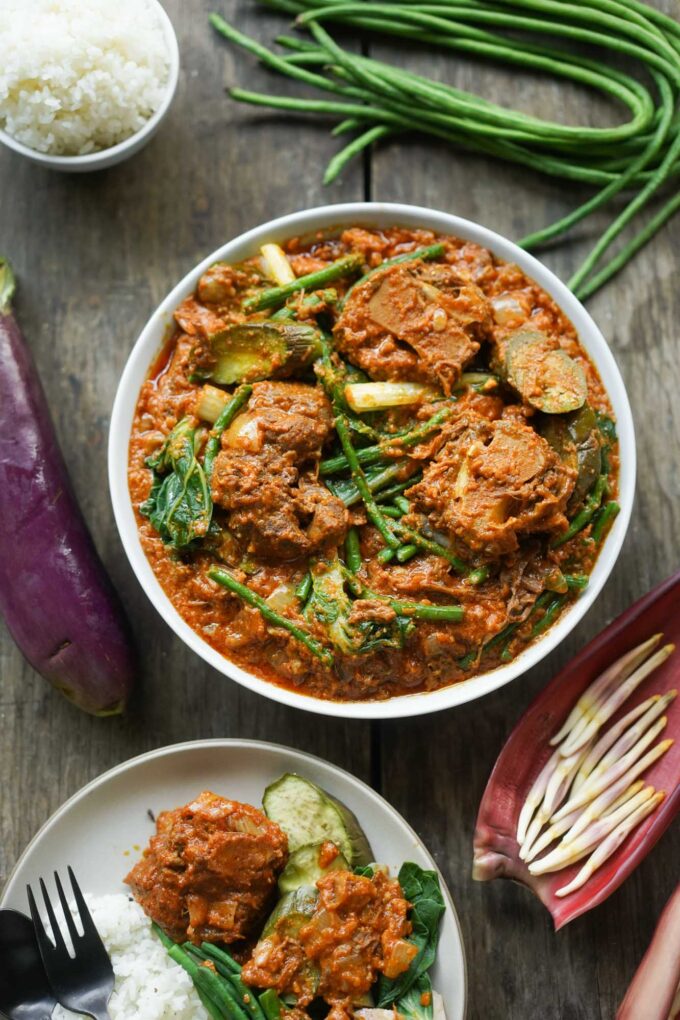
This famous Filipino stew is truly a labor of love. It combines hours-long stewed meat and tender traditional vegetables like eggplants and long string beans in a savory peanut sauce. Think of this as a sort of Filipino curry, although instead of cumin or masala, this uses peanuts and annatto powder (or achiote oil) as some of the main seasonings. It also uses rice powder as a thickening agent.
Kare kare has many origins, from precolonial Moro cuisine to Pampampangan kari to soldiers from the Mughal Empire in India. These days, it’s a well-known comfort food with an interesting peanut and peanut butter-based stew. While I love braised oxtail in my kare kare, it also comes in different variations with seafood, pig feet, and even tripe.
8. Lechon Belly (Cebu Roasted Pork Belly / Cebuchon)
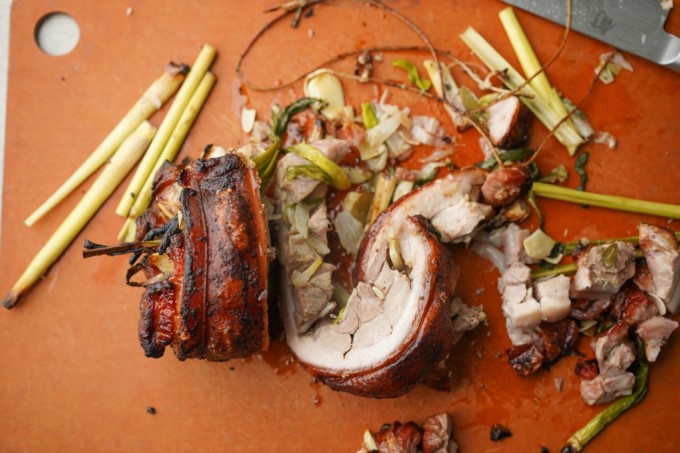
While the influence of lechon came during Spanish colonization, the Filipino people have definitely made it their own, especially in Cebu. Cebu is known for many things, and lechon is a hallmark food of this Visayan region. Lechon is often seasoned with lemongrass, basil, scallions, and lots and lots of garlic. And the most memorable characteristic is the extra crunchy and golden pork skin.
When you can’t order a full lechon for your party or dinner, then Cebuchon (a shortened version of “Cebu Lechon”) or Lechon belly is a delicious option for garlicky and citrusy seasonings and ultra-crispy skin. It’s basically a slab of rolled pork belly with seasonings inside. I roast this over a grill with a rotisserie attachment and brush on a light layer of milk every so often to get a golden and crispy skin.
If you want other options to buy Cebuchon near you, search for local Filipino restaurants like Grill City or buy them pre-marinated at stores like Weee! or Island Pacific.
9. Pork Adobo (Stewed Pork Belly w/ Eggs) and Chicken Adobo
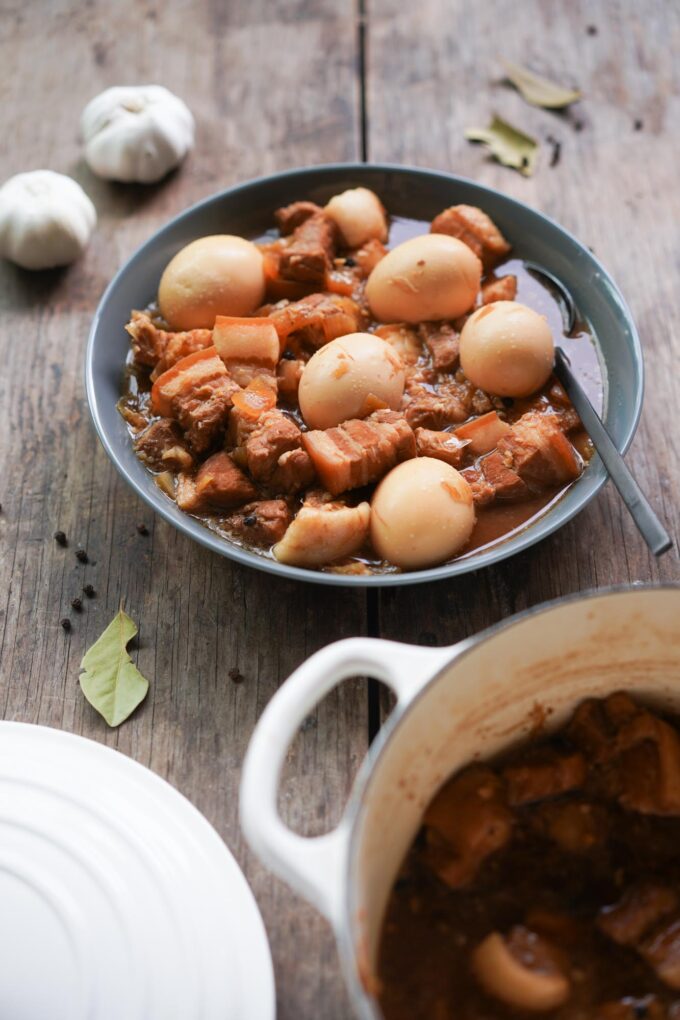
Tangy and rich pork or chicken adobo stew over a steaming bowl of hot jasmine rice is one of the best comfort foods in the Philippines. Filipino adobo might sound similar to its Spanish cousins, but it’s a dish indigenous to the Philippines. Spanish adobo combines spices like paprika and oregano, but Filipino adobo is based on vinegar and soy sauce seasoning. This tangy and savory mix was formed as a way to preserve food before refrigerators were readily available.
These days, there are many ways to cook adobo, depending on the region you’re from in the Philippines or just based on family recipes. For example, some families like adding coconut milk to their adobo or using fish instead of the more popular pork or chicken adobo recipes.
Whatever the recipe, I like to use Datu Puti’s Sukang Maasim. This is a Filipino cane sugar vinegar that’s in between the pungent flavor of white vinegar and white wine vinegar (or apple cider vinegar).
10. Pancit Palabok (Rice Noodles w/ Pork & Shrimp)
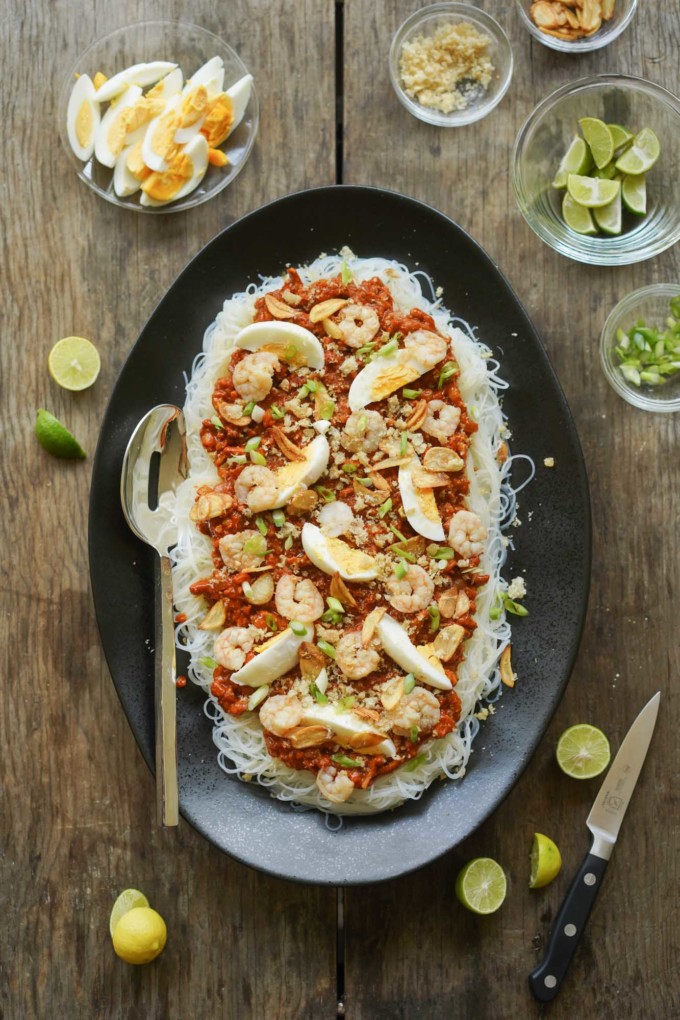
If you like flavorful umami noodles that are packed with tender shrimp and pork, crunchy morsels of cracklins, fried garlic, and zesty limes, then you need to try pancit palabok (or Filipino rice noodles with pork and shrimp). This recipe uses lots and lots of flavor to make a rich ragu-like sauce, from the homemade seafood stock to the fish sauce. But my favorite part of this dish is the unlimited toppings you can add: thinly sliced scallions, chicharron, sliced eggs, fried garlic or onions, and lots of lime juice mixed in.
There are many different types of pancit (or noodles) in Filipino cuisine, and the term comes from the Hokkien word “pian e sit” (which means a dish that is conveniently cooked). Noodles are a big part of Filipino culture, and we typically eat them for many celebrations like New Year’s Eve or on someone’s birthday because they represent long life–a characteristic passed down from Chinese immigrants and travelers.
11. Pork Stew w/ Mixed Vegetables (Linat-Ang Baboy)
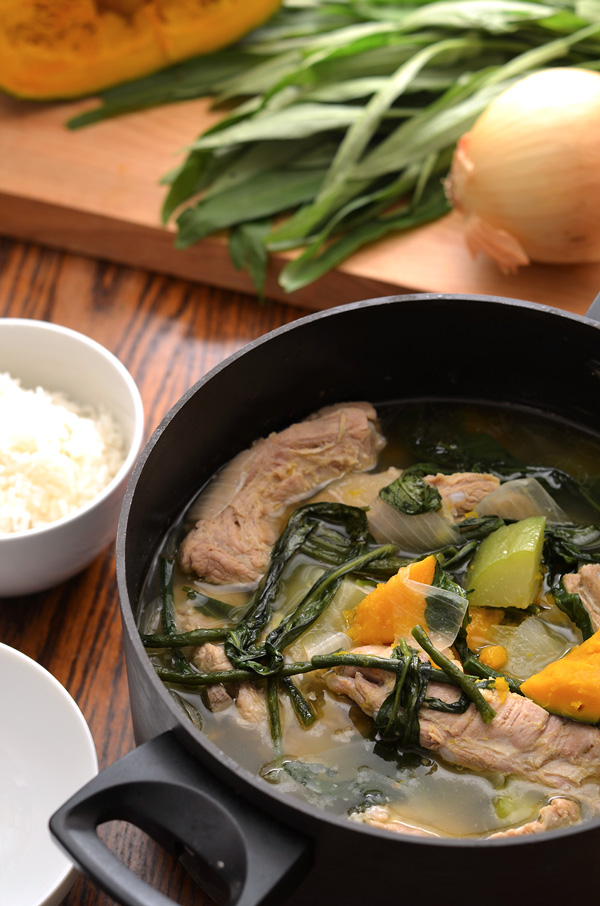
Instead of the more popular sinigang, I grew up with linat-ang baboy, Cebuano’s version of Filipino pork stew with mixed vegetables. Compared to its famous Tagalog counterpart, it’s not sour and has a more savory and rich flavor. “Linat-an” means boiled until very tender, which makes this pork stew so delicious–the extra tender pieces of pork and vegetables, like kabocha.
Not to be outdone by pork, the vegetables in this stew are also hearty and tasty. My favorites are the earthy string beans, sweet kabocha squash, mildly nutty ong choy (or kang kong leaves), and fresh chayote. Unfortunately, I don’t often see this clear-broth stew at restaurants or fast food joints because it’s mostly a home-cooked meal. The good news is that it’s super easy to make. Most of the work is waiting for the pork to simmer until it’s tender.
12. Pancit Canton (Stir-Fried Noodles)
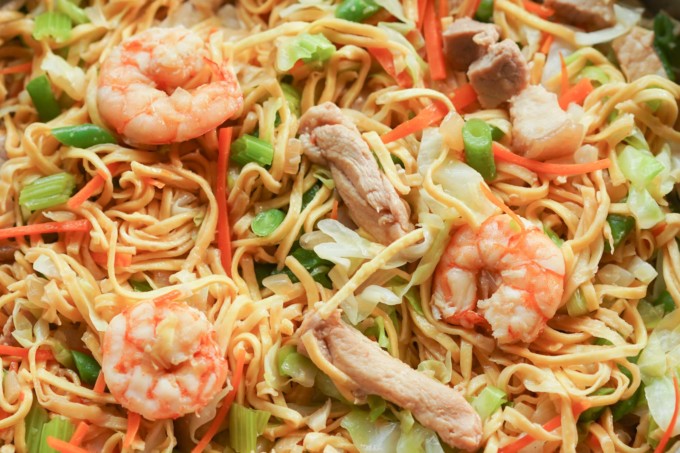
Pancit Canton is another Filipino noodle dish that is a popular item at parties and celebrations. It’s packed with wheat noodles, crunchy cabbage, sweet carrots, fresh string beans, rich pork belly, shrimp, and juicy chicken thighs mixed in a savory soy sauce seasoning.
Think of it as similar to chow mein. The name Pancit Canton is actually derived from the Hokkien word “pian e sit” which means a dish that’s easy to cook. It references the Guangdong (formerly Canton) region of China. These days, you can find packaged pancit canton in the grocery store if you ever need an instant noodle meal. You can also buy it from old-school restaurants like Pinoy Pinay.
13. Chicken Tinola (Tinolang Manok)
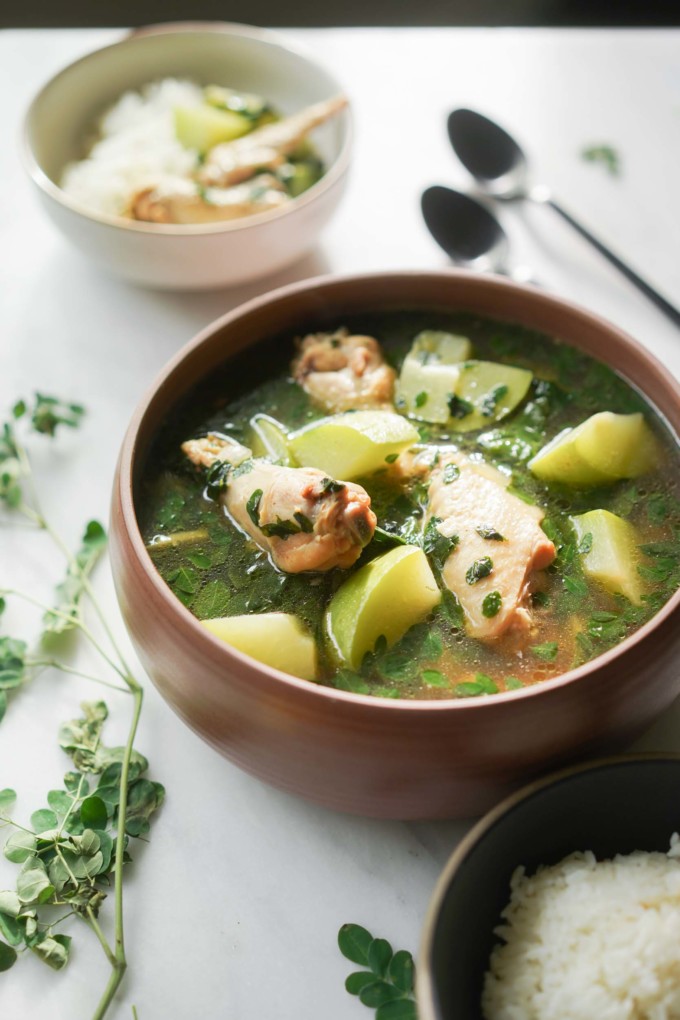
Chicken tinola is perfect for those cold and rainy days – think of it as Filipino chicken soup. This soup is made with tender chicken, fresh chayote, fragrant ginger, and earthy malunggay leaves (aka moringa leaves).
This savory soup is especially great if you’re feeling under the weather–the moringa leaves are also full of Vitamin C and beta-carotene. You can also buy chicken tinola at many old mom-and-pop Filipino restaurants, like Gerry’s Grill or Pinoy Pinay, if you don’t have time to cook it at home.
14. Pandesal (Soft & Fluffy Filipino Bread Rolls)
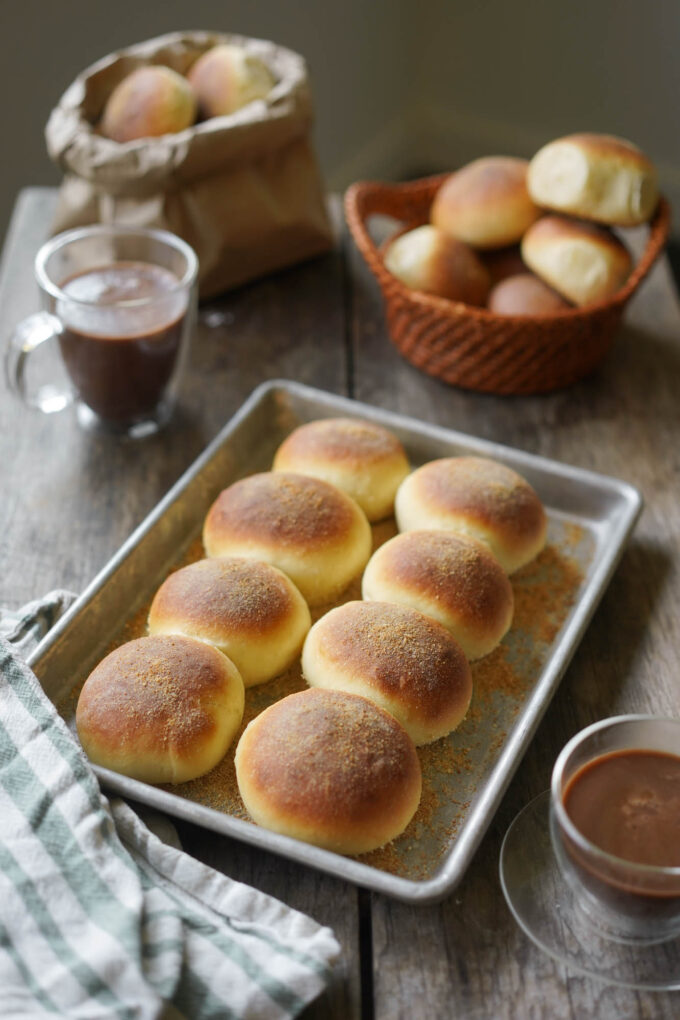
Pandesal are slightly sweet and buttery bread rolls. I will always have fond memories of buying pandesal in the early mornings with my Lola from the local bakery. It’s a breakfast staple and is often eaten with hot coffee (or hot chocolate for kids) in the morning. They’re kind of like the Filipino version of sweet Hawaiian rolls but have a drier crumb crust outside.
This sweet bread comes in different forms too. There is a version that has meat stuffed inside – this is the perfect on-the-go snack that’s similar to pork bao. If you want something sweet, there’s pandesal made with ube dough and it’s tasty. You can make this at home with my recipe, but it’s also super easy to buy at your local Filipino grocery store (like Seafood City), point-to-point restaurant, or bakery like Goldilocks. A hot tip is buying the freshly made pandesal at Goldilocks that’s packaged in a paper bag instead of prepackaged pandesal that’s shipped to the store.
15. Filipino Beef Empanada Recipe (Baked & Delicious!)
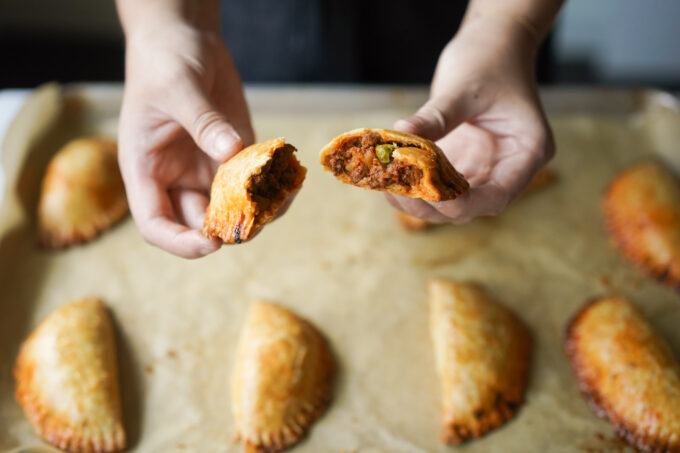
I grew up with these flakey and buttery empanadas stuffed with savory and hearty beef filling. Little did I know that they were super easy to make at home. The filling is based on a tomato sauce and mixed with beef, onions, garlic, carrots, and peas. Unlike my mom’s version, I do not add the raisins based on my preference, but the traditional version includes them. Since the filling has a bit of a sweetness to it, it’s similar to the Cuban picadillo.
If you make this at home, the recipe is easy and beginner-friendly. You can prep the ingredients a day ahead of time and assemble them whenever you’re ready. However, you can also find empanadas at Filipino bakeries like Goldilocks or Red Ribbon.
16. Atchara Recipe (Easy Filipino Pickled Papaya)
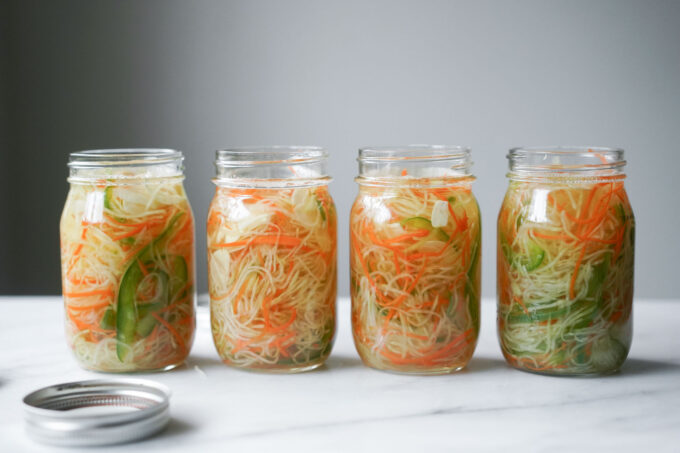
What’s any Filipino meat dish without its tangy counterpart, atchara? These Filipino pickled papaya and carrot condiment balances the richness of bbq skewers, lechon, tocino, or any meat with the perfect amount of acidity and tanginess. If you’re familiar with Vietnamese food, it may look similar to the Vietnamese pickles (đồ chua) you get in bánh mì or other dishes, but these are slightly different.
Atchara uses green papaya instead of daikon and is packed with garlicky and sweet flavors in the brine. It’s slightly vinegary because it uses cane vinegar–a Filipino staple that’s also found in chicken adobo. What’s best about this recipe is that it’s a quick ferment, and you only need about 24-48 hours to brine the pickles.
17. Ginisang Munggo
Mongo is a Filipino savory stew with a mung bean base and often includes protein like pork, chicken, or fish. The name translates to “sauteed mung bean” in Tagalog. I often ate this at home growing up and my parents lovingly referred to it as mungos as a nickname. Its savory flavor pairs perfectly with a hot, steaming bowl of Jasmine rice and just hits the spot when you’re sick or it’s rainy outside.
Of course, my favorite comfort food is made by my mom. She adds tons of fragrant ingredients like garlic, stewed greens, and rice noodles. I especially enjoy the crunchy pieces of chicharon as a topping.
18. Dinuguan
Pork blood stew doesn’t sound like the most appetizing dish, but believe me when I say it’s one of my favorite Filipino comfort dishes to eat with a bowl of steamed Jasmine rice. If you enjoy Irish black pudding (aka blood sausages), then dinuguan might be your next Filipino favorite. It’s made of pork innards (intestines, lungs, heart, ears, and other parts) and blood stewed with savory spices and vinegar. My mom’s specialty includes chopping pork belly into small pieces throughout the stew to make it super rich.
The name dinuguan means “to be stewed in blood” and derived from the word dugo means “blood” in Filipino. There are many regional names for dinuguan, and growing up Cebuano, we referred to it as dugo dugo. Often times, parents refer to it as “chocolate meat” to their kids.
19. Chicken Inasal (Filipino Grilled Chicken)
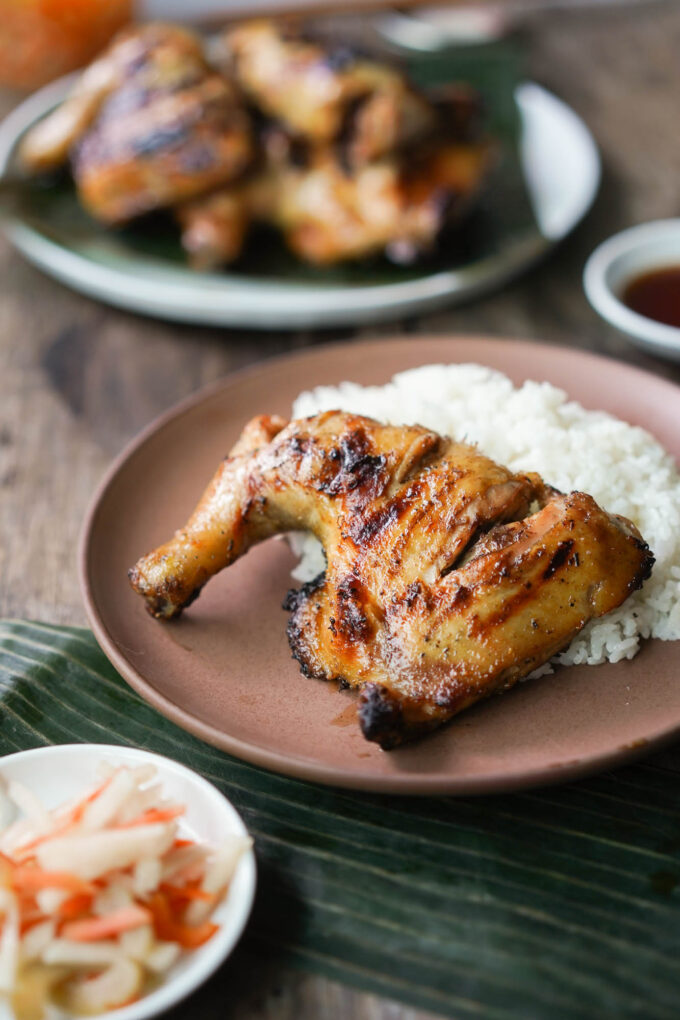
Chicken inasal is one of my top Visayan grilled dishes. It’s made with a marinade based on achiote oil (or annatto seeds simmered in hot oil), lemongrass, garlic, ginger, lime juice, sugar, and cane sugar vinegar. The chicken is marinated for at least 8-10 hours, giving you the best spiced and citrusy seasoning. Combine this with the charbroiled flavor from the grill over a bed of hot rice, and I swear it’s the best BBQ chicken you’ll ever eat.
Restaurants like Mang Inasal from the Philippines and Grill City in the US are well-known spots for chicken inasal. I would definitely recommend adding chicken inasal to your next BBQ, especially if you want to make a boodle fight at home.
20. Arroz caldo / lugaw
When you’re sick and need some comfort, or you just want a good and flavorful rice porridge, try arroz caldo. While the name is derived from the Spanish dish arroz caldoso, which is made from a brothy short-grain rice dish, rice porridge is also influenced by Chinese immigrants and congee. Arroz caldo is another type of lugaw from the Philippines or rice porridge.
Arroz caldo is made of a base of sticky rice and chicken simmered with lots of ginger, garlic, and scallions. It can be eaten with fish sauce or calamansi and eggs. It’s pretty similar to cháo gà (Vietnamese chicken rice porridge). Prepackaged arroz caldo can be found at grocery stores like Island Pacific or Seafood City, but freshly made arroz caldo can also be found at bakeries and restaurants like Goldilocks or Red Ribbon.
21. Balut
Like dinuguan, balut can get a bad rap because it’s seen as quite an “exotic food.” It’s a fertilized duck egg embryo; if you ask me, it’s delicious and super tasty. However, I will say that I grew up eating balut from the local barrio balut man since I was a child, and I have fond memories of buying and eating this on the streets of Cebu.
It’s similar to Vietnamese balut–it even keeps the Tagalog the same. The differences lie in the incubating period. Filipino balut is incubated between 14-18 days, whereas Vietnamese balut is incubated between 19-21 days. Roughly, this means that the Filipino balut is less developed. If you’re starting out, I would recommend eating Filipino balut because it’s less shocking when you eat it.
When you buy balut at the grocery store, you’ll need to heat it by simmering it in water for 30 minutes to cook it. Then, peel the top part of the eggshell and sip out the flavorful broth. Use salt to eat the rest of the bird. You can find precooked balut from point-to-point restaurants like Pinoy Pinay or the Filipino grocery store.
22. Puto (Filipino Steamed Rice Cakes)
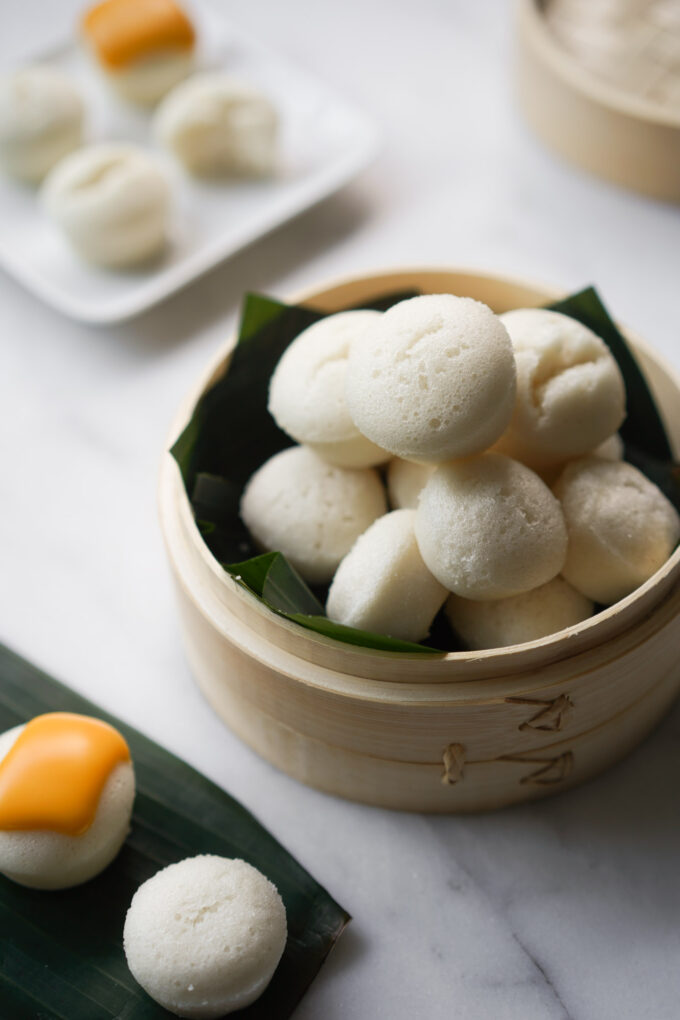
Puto is a very popular variety of kakanin, or rice cakes, from the Philippines. Traditionally, it’s made from fermented rice batter, but these days, most recipes are made from rice flour and not fermented. After steaming, you get plump, spongy little cakes that are slightly sweet and often topped with cheddar cheese and other ingredients.
You can find many variations of puto, such as ube or pandan flavors. It’s pretty easy to make a batch at home with rice flour, but premade mixes are available at grocery stores like Seafood City. You can also buy fresh puto at Filipino bakeries and restaurants.
23. Biko (Filipino Sweet Rice Cake w/ Latik Topping)
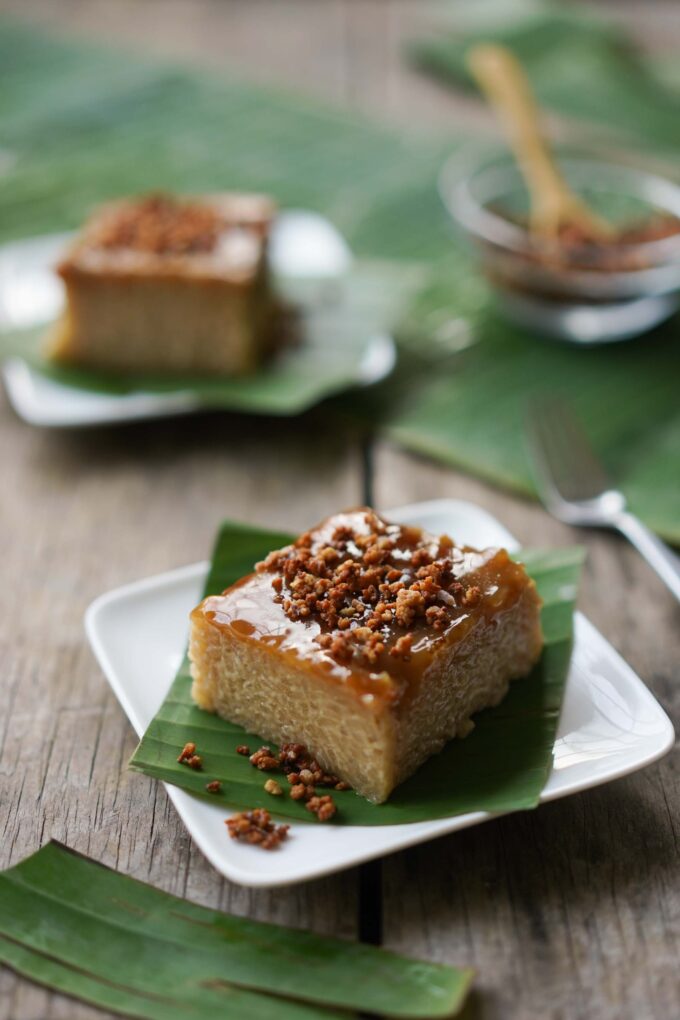
Think of biko as a decadent, caramelized brown sugar sticky rice cake topped with crispy bits of fried coconut. It’s also another form of kakanin, or rice cake, and involves a two-step process of stovetop cooking and baking. Whenever I see this at a party, I add it to my dessert plate.
Making biko can be a labor of love because you’ll be stirring over the stove for a while, but it’s so deliciously good that everyone will thank you for making it. If you’re not up for cooking, I’ve always found them available at Seafood City. However, be warned: It’s never as good as homemade.
24. Filipino Halo-Halo Recipe (w/ Leche Flan, Razon’s Style)
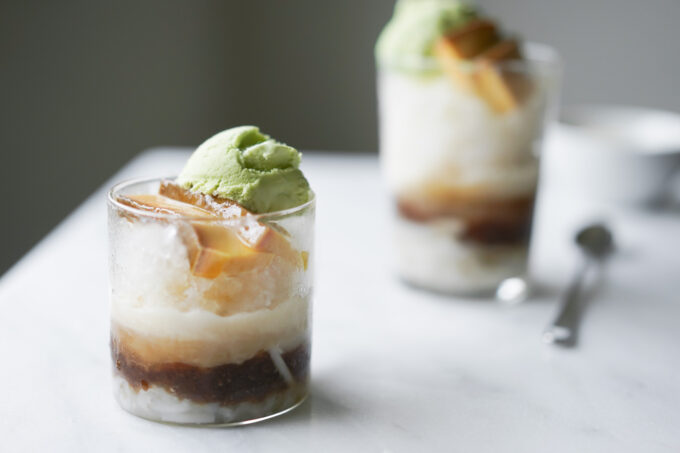
Halo-halo is a very popular dessert associated with the Philippines, but did you know that its origins are influenced by Japanese kakigori from migrants during the 20th century? It’s essentially shaved ice with a milk sauce and various toppings. These days, halo-halo is synonymous with many different toppings like coconut jelly, coconut strips, fruit slices, ube halaya, ice cream, and sweet beans.
However, there are actually lots of variations of halo halo. And my favorite is the Pampangan style from Razon’s of Gagua. My cousin took me to try this the last time I was in the Philippines, and it’s been my favorite variety since then. This specific style has shaved ice that’s topped with evaporated milk, caramelized bananas, leche flan, and ice cream. It’s super decadent, and I love the flavor. Unfortunately, I can’t find a similar kind in California, so I’ve had to make my own recipe.
25. Ube Crinkle Cookies (Filipino Purple Yam Cookies)

Crinkle cookies are delicious and addictive. I’ve made these chewy and rich cookies dozens of times for friends and family. Ube is a purple-colored yam native to the Philippines. It has a nutty and vanilla flavor profile and works well in many desserts. The ube flavoring makes these cookies taste sweet and nutty and gives you a satisfying chew.
Crinkle cookies originated in the US but became very popular in the Philippines during the holidays. And now that there’s a big ube trend, ube crinkle cookies are trending. These days, I see them in many cafes and grocery stores around California.
26. Bibingka Recipe (Filipino Baked Coconut Rice Cakes)
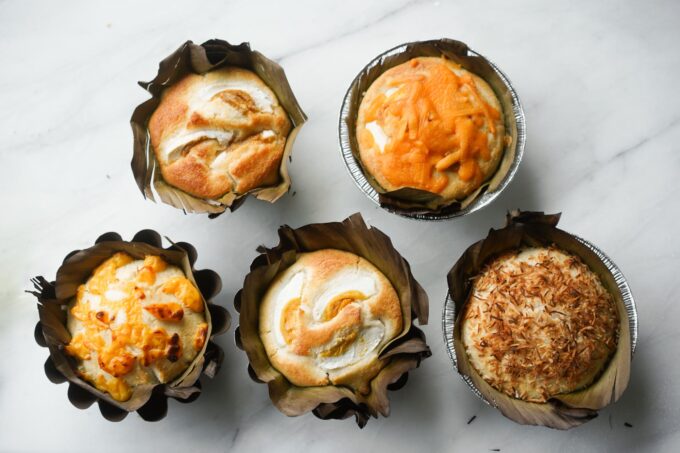
Another popular kakanin during Christmas time is bibingka, a rice cake that’s oven-baked and topped with many different flavors like cheese, salted egg, ube, and more. If you ever visit the Philippines during Christmas, you’ll find bibingka vendors making bibingka over hot charcoal and banana leaf-lined cast-iron pans.
Bibingka has the most traditional texture as a cake because it’s tender and soft. Traditional variations of bibingka actually have a more tangy flavor because they’re made up of fermented glutinous rice batter (similar to Puto’s original recipe). My recipe is more modern and sweet and uses rice flour to make it easier. You can find fresh-made bibingka at your local Filipino bakeries or restaurants.
27. Turon Recipe (Filipino Banana Lumpia w/ Caramel)

Whenever I go to a Filipino party, I secretly hope there’s turon because it’s one of my favorite desserts. Turon is a sweet lumpia variety with a caramelized and crispy layer of egg roll wrapper and a center of juicy jackfruit and saba banana. What makes turon unique is the use of saba bananas, which are initially from the Philippines. They are chunkier than traditional American bananas and have thicker skins. When they’re raw, they have a starchy and citrusy flavor profile. As they cook, they have a rich sweetness that comes through with each bite of turon.
In the Philippines, turon is sold by street vendors, and in the US, it is sold at local bakeries like Valerio’s. At Filipino restaurants, turon is often served with ice cream on the dessert menu.
28. Ube Cake (Filipino Purple Yam Cake w/ Macapuno)

Combine ube with anything, and it’s a hit, especially in cake form. Ube cake has soft chiffon layers of nutty vanilla flavor and is layered with milky coconut jam. My recipe for ube cake even has a coconut buttercream frosting that adds a “not too sweet” layer on top.
I’ve had variations of ube cake with macapuno (or coconut string jam) throughout my lift from Goldilocks and Red Ribbon (either in a cake roll or traditional round cake style), and they always hit the spot. I recommend picking up an ube cake from these stores if you’re nearby because making chiffon cake at home can be tricky.
29. Ginataan Bilo Bilo Recipe (Rice Balls, Sweet Potato & Coconut Dessert)
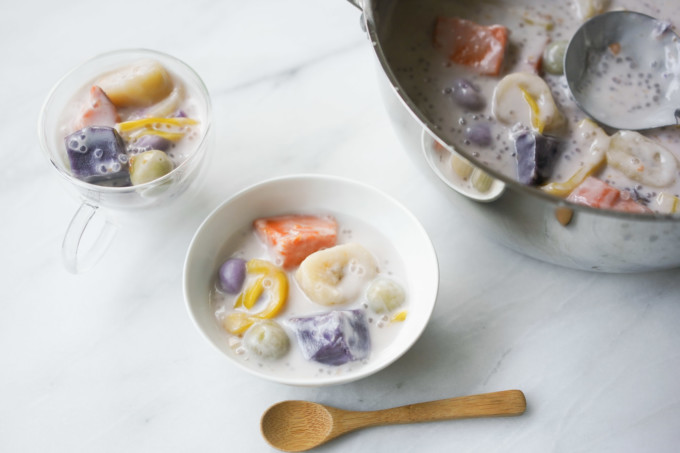
Ginataan bilo bilo is a comfort dessert perfect for rainy days. Sweet soup is not a typical American dessert type, but it’s common in Asian cultures. This dessert consists of a milky coconut base, chewy bilo bilo (mochi balls), sago pearls, saba banana, tender sweet potatoes, and juicy jackfruit slices. While you can eat this dessert cold, I prefer hot and steamy.
Ginataan translates to cooked in coconut, so it makes sense that the base of this sweet soup is made from coconut milk. Bilo comes from the Tagalog word “bilog,” which means ball. There are so many variations of ginataan, like savory versions that have kabocha and shrimp.
My mom makes a Cebuano version called binignit, which is often eaten during Holy Week in the Philippines. If you don’t have a Filipino mom to make this for you, you can easily make it at home with my recipe. Sometimes, you can also find local Filipino mom-and-pop restaurants that serve ginataan bilo bilo.
30. Suman / bud bud
Depending on where you are in the Philippines, this sticky rice mixed with coconut milk wrapped in banana leaf (or palm or coconut leaves) dessert could be called suman or bud bud. It’s also made with cassava instead of glutinous rice in some variations. In Cebu, we call it bud bud pilit and it’s often eaten sprinkled with cane sugar or coconut syrup. These days, I’ve also seen versions where there’s a filling like chocolate or ube in the center.
For even more Filipino foods, check out all the savory and sweet recipes I have here to learn more about Filipino culture and food.









